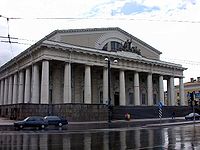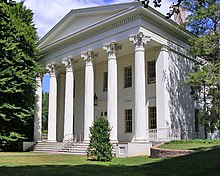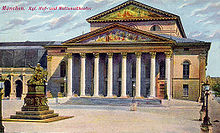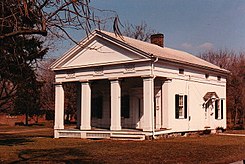Talk:Greek Revival architecture
| This article is rated B-class on Wikipedia's content assessment scale. It is of interest to the following WikiProjects: | |||||||||||||||||||||||||||||||
| |||||||||||||||||||||||||||||||
|
|
Saint Petersburg Bourse
[edit]I appreciate the enthusiasm some users have for adding this picture to the page, but I'm going to have to resist sharing it. As I've said elsewhere adding pictures without context is not creating content. The Bourse is not mentioned in the text, I have no idea where it fits into the development of Greek revival, nor would any other reader. To my eye the diocletian window and peristyle make it an atypical example of the style, just how influencial was it? Again our anonymous grangerizer doesn't tell us. A new section on the Baltic Greek revival would be most welcome, if it included information on Finland, Lithuania, Poland and Denmark as well as Russia and placed each in the wider historical development. Then perhaps you might like to illustrate that. Twospoonfuls 11:44, 1 March 2007 (UTC)
I'm starting to feel like I'm victimizing this poor fellow, but I really can't make my mind up if the latest effort is tantamount to vandalism or just pitifully inept. The Russian boosterism is touching but central Petersburg is largely Naryshkin Baroque and Rastrelliesque, the author really needs to be a lot more specific and detailed. So I'm going to post it here and invite anyone to amend it before it is reinserted. Twospoonfuls 12:55, 4 March 2007 (UTC)
Greek revival in Russia
[edit]
The historical center of Saint Petersburg was rebuilt by Alexander I of Russia, and so the Greek revival had a debut in Russia. On the Strelka of the Vasilievsky Island the Saint Petersburg Bourse was built, a forty four Doric columns temple. Leo von Klenze expanded the Hermitage Museum and made an other example of this style.
- Yes, adding this. Johnbod (talk) 20:11, 23 February 2016 (UTC)
Greek revival in X
[edit]I was afraid of this. This article is in danger of degenerating into an unencyclopedic list of Greek-revival-buildings-I-have-heard-of like the example above or the section on Canada. Perhaps we need to thresh out the minimum criteria for inclusion in the article, which ought to include some mention of an architect or work's importance within the historical development of the style. It simply isn't good enough to add pictures or text without indicating how their subject stands within the larger context of the topic as a whole. Twospoonfuls (talk) 18:55, 11 January 2008 (UTC)
- There's a lengthy section of the US so I didn't think a few Canada examples would be controversial. The two buildings I added are fairly prominent examples, along with a link to the Ostell article contextualizing his role up here. Shawn in Montreal (talk) 05:34, 12 January 2008 (UTC)
- I think the Ostell reference is notable because he apparently did a lot of prominent Greek Revival public buildings. But if you feel this is all just an add-on, please just delete. I think I see what you're trying for here, i.e., something more synthesized than some of the other architecture articles, which do degenerate into mere lists. As you wish, Shawn in Montreal (talk) 06:02, 12 January 2008 (UTC)
P.S. I threw in an article on the author of St. Pete Exchange, Jean-François Thomas de Thomon. There's hardly a trace of Greek Revival in any of his works - it's an old-school, academic French neoclassicism of ancien regime. NVO (talk) 05:15, 14 October 2009 (UTC)
Drawing the line
[edit]Is it possible to draw the line between neoclassicism and Greek Revival, and the line Greek Revival and Neo-Grek ? just curious. The difference between Empire neoclassicism and Neo-Grek is evident even to an untrained eye (perhaps it's my personal misconception shaped by living in a culture that happily missed Greek Revival wave), but throw in "Greek Revival" and it all blurs together... NVO (talk) 05:11, 14 October 2009 (UTC)
Correctly captioned?
[edit]I'm wondering if the date given for Thomas Hamilton's design for The Royal High School (1831) is correct, given that the building was erected between 1824 and 1829? Kim Traynor | Talk 20:03, 26 May 2014 (UTC)
- It is, as the drawing was after the fact (as was always clear from the image file). Now clarified. Johnbod (talk) 20:20, 23 February 2016 (UTC)
Vernacular Greek Revival
[edit]This current Greek Revival architecture article doesn't cover the usage of "Greek Revival" in the United States for architecture of balloon-frame houses during the early 1800s. There has been the same problem for Second Empire architecture, being discussed in a couple sections of Talk:Second Empire architecture in Europe. (@Carptrash and Giano:)



I currently think that this might fairly be called Vernacular Greek Revival architecture (currently a redlink), or at least it is sometimes called that, as in California's Historic Resource Inventory description of Odd Fellows Hall (La Grange, California). Hmm, but from experience with documentation of many NRHP-listed buildings, I think it is more often just called "Greek Revival architecture". Virginia & Lee McAlester, in A Field Guide to American Houses (with chapter on Greek Revival, pages 176-195), call Greek Revival the first popular Romantic style in the U.S. Running from about 1820 to 1860 (note the American Civil War interrupted in 1861), they say it was "dominant from about 1830 to 1850 (to 1860 in the South)", which agrees with the usage in NRHP nominations. Category:Greek Revival architecture in the United States by state now contains more than 500 articles, without distinguishing between the lower/looser/lighter/vernacular Greek Revival often used in houses vs. the high/traditional Greek Revival that is used in many government and commercial buildings and in mansions.
As with Second Empire architecture, I think this ought to be explicitly covered in a section, perhaps within "North America" section, in this article. To be called, for now, "Vernacular Greek Revival in the U.S."? Or "Greek Revival in the U.S."? Usage of the term in Canada is likely very much the same, but I don't have sources saying that. --doncram 16:20, 21 October 2016 (UTC)
- There is ridiculous inflation of this and other such terms (neoclassical, Queen Anne etc.) in the US. The house illustrated is a good example - really it is entirely meaningless to use "Greek Revival" in relation to it, and doing so is just a matter of fashion, since there is absolutely nothing that does not relate as closely to Roman or Renaissance/Baroque architecture as to Greek, and the "open pediment" or shortened bottom of the typanum is I think never found in Greek architecture,[1] but common in the others. But I realize that local American sources do this all the time. I don't think anything but a see also belongs in this article, and any new article should clearly specify US in the title, or North America if you can catch the Canadians in the act. It would be good to have something more appropriate that articles like that house can link to. There are American sources complaining about this inflation of terms, which it would be good to use (sorry, can't remember where).Johnbod (talk) 17:27, 21 October 2016 (UTC)
- ^ Oh, perhaps it did in late-Hellenistic Alexandria, but no examples survive.
- Right off the bat we are presented with "ridiculous inflation ... in the US." A preview, I suspect of what is to come and a comment that does not qualify as tossing down the gauntlet of peace. But I shall pick it up anyway. I am currently engaged in writing an article about Talbot Hamlin, best known for authoring the book "Greek Revival Architecture in America" but have gotten viscously sidetracked by his HUAC connections and those to Ginling College, where an important role was played in the Nanking Massacre. However I shall get back to Greek Revival in America in the next while. My "Guide to Canadian Architectural Styles" lumps buildings such as http://www.historicplaces.ca/en/rep-reg/place-lieu.aspx?id=3542 as "Neoclassical" but the web link refers to it as "Greek Revival". In the US the style was adapted somewhat because at the time the USA considered its self to be the heirs of ancient Greek democracy, but Canada did understandably not share this view. So gird your loins and let the games begin. Carptrash (talk) 18:10, 21 October 2016 (UTC)
- It's OK, Carptrash, I don't really get Greek Revival Architecture, and I can think of very few buildings that fall genuinely into such a category. All I will say about Odd Fellows Hall (La Grange, California) is that its Greek revival elements are very subtle indeed. Giano (talk) 19:23, 21 October 2016 (UTC)
- Giano And is architectural history not a subtle endeavor? But don't worry, when I finish the Talbot Hamlin article, author of "Greek Revival Architecture in America" I will have a hundred or two buildings that fall into that category. Carptrash (talk) 19:31, 21 October 2016 (UTC)
- (ec) Indeed we can all agree it is ridiculous inflation for "Greek Revival" to be applied there, but...it is what it is called, in this case with apologetic qualifier "Vernacular". "Greek Revival architecture" in Wikipedia should cover this, simply because it is what the term is, in common usage. Common usage among, well, people who have browsed a lot of NRHP nominations, or have otherwise become somewhat informed. (Very few Americans have any architectural terms at all in their vocabulary to describe buildings, though I sorta vainly hope Wikipedia's provision of coverage of local NRHP-listed buildings that are everywhere in the U.S. may eventually change that.) There is a continuum unfortunately, with no cutting point definable IMO, from the Odd Fellows Hall's low level up to Samuel Wadsworth Russell House's high style. And the full range occurs in domestic and commercial and governmental, too. Great to hear that Carptrash has a guide to Canadian styles and more, and can get around to here. --doncram 19:36, 21 October 2016 (UTC)
- P.S. It would be really good to use, as Johnbod says, American (or other) sources complaining about this inflation of terms. --doncram 19:40, 21 October 2016 (UTC)
- CarptrashI look forward to seeing them - hopefully a little less subtle than the example above. Now I come to think about it: there are one or two good examples of Greek Revivalism in the world - Walhalla memorial and the British Museum, but I am hard pressed to think of many more - there's that one in Munich with the big ugly statue, but I forget its name. Most times the architect just gets plain lost between Roman and Greek and we end up with a sort of mongrelised Palladianism. Sadly, one oversized portico will not suffice to hoodwink. Giano (talk) 19:42, 21 October 2016 (UTC)
- Giano And is architectural history not a subtle endeavor? But don't worry, when I finish the Talbot Hamlin article, author of "Greek Revival Architecture in America" I will have a hundred or two buildings that fall into that category. Carptrash (talk) 19:31, 21 October 2016 (UTC)
- It's OK, Carptrash, I don't really get Greek Revival Architecture, and I can think of very few buildings that fall genuinely into such a category. All I will say about Odd Fellows Hall (La Grange, California) is that its Greek revival elements are very subtle indeed. Giano (talk) 19:23, 21 October 2016 (UTC)
- Right off the bat we are presented with "ridiculous inflation ... in the US." A preview, I suspect of what is to come and a comment that does not qualify as tossing down the gauntlet of peace. But I shall pick it up anyway. I am currently engaged in writing an article about Talbot Hamlin, best known for authoring the book "Greek Revival Architecture in America" but have gotten viscously sidetracked by his HUAC connections and those to Ginling College, where an important role was played in the Nanking Massacre. However I shall get back to Greek Revival in America in the next while. My "Guide to Canadian Architectural Styles" lumps buildings such as http://www.historicplaces.ca/en/rep-reg/place-lieu.aspx?id=3542 as "Neoclassical" but the web link refers to it as "Greek Revival". In the US the style was adapted somewhat because at the time the USA considered its self to be the heirs of ancient Greek democracy, but Canada did understandably not share this view. So gird your loins and let the games begin. Carptrash (talk) 18:10, 21 October 2016 (UTC)

Sorry to all, it seems that some feel that I agree with the phrase " ridiculous inflation " as applied to our GR buildings and I do not. As with everything else correctly done on wikipedia the term is used because it fits. And because it is supported by reputable sources. Although the folks who fill out NRHP nominations might not be the most savy lot, those that review them and approve them are usually SHPOs, who do understand what the style is and when it is correctly and not corruptly applied. Not quite sure what " oversized portico will not suffice to hoodwink." refers to Carptrash (talk) 19:48, 21 October 2016 (UTC)
- I am saying that a supersized portico and few columns does not mean a building is anything in particular; it more often signifies an architect working for a patron with ideas above his station. At the end of the day, he who pays the architect often calls the tune - and he who has made a fortune selling bootleg liquor is often not an acknowledged expert on classical architecture. It's just the way that the world goes around. Giano (talk) 19:54, 21 October 2016 (UTC)
Yes, I agree with you that the patron does not get to name the style, that is the art historian's task. Or those of us who pick up the mantle here. Anyway, included is a picture of GR in the US. It's a sample of what it about to appear. Also Americans are inclined to avoid characterizations such as "above his station" as being particularly "Old World" and not so applicable in the New.Carptrash (talk) 20:55, 21 October 2016 (UTC)
- Second Bank of the United States is certainly Greek Revival, as in an early Doric style in the German manner. But as I said above (differently), when merely having regular windows and the door in the centre becomes a mark of "Greek Revival" style (given that the kind of Greek buildings being "revived" conspicuously lacked any windows at all), this needs to be clearly segregated, and it needs to be clear that this terminology is strictly a US thing, and distinct from the fewer serious stone buildings in a real attempt to achieve a Greek-ish neoclassical style. As you say, the use of the term is essentially political rather than architectural. But this terminology does exist locally in more-or-less RS sources, and an article explaining it is fine, just like Queen Anne style architecture in the United States. We could also do with articles on the "Italian" style in Victorian building in Britain, with which there is some overlap; but that wouldn't belong in Italian architecture. Johnbod (talk) 04:27, 22 October 2016 (UTC)
- No, it would belong here. Surely, Carptrash's example above is inspired by Maison Carrée? Giano (talk) 11:09, 22 October 2016 (UTC)
- Ah, hadn't seen that - but there are vernacular extensions to that style in much smaller houses in similar fashion. There isn't much difference between later Greek/Hellenistic/Greco-Roman architecture and straight Roman architecture, but the Greeks did like to have columns all the way round, while the Roman temple usually kept the old Etruscan style of just a columned portico. But this is missing the point. This stuff is not called "Greek Revival" (by some) because it has any real resemblence to Greek architecture but as matter of marketing/fashion/aspiration, all with a political twist. That is why it should be in its own article, so as not to confuse non-American readers. Johnbod (talk) 13:15, 22 October 2016 (UTC)
- No, it would belong here. Surely, Carptrash's example above is inspired by Maison Carrée? Giano (talk) 11:09, 22 October 2016 (UTC)
- Second Bank of the United States is certainly Greek Revival, as in an early Doric style in the German manner. But as I said above (differently), when merely having regular windows and the door in the centre becomes a mark of "Greek Revival" style (given that the kind of Greek buildings being "revived" conspicuously lacked any windows at all), this needs to be clearly segregated, and it needs to be clear that this terminology is strictly a US thing, and distinct from the fewer serious stone buildings in a real attempt to achieve a Greek-ish neoclassical style. As you say, the use of the term is essentially political rather than architectural. But this terminology does exist locally in more-or-less RS sources, and an article explaining it is fine, just like Queen Anne style architecture in the United States. We could also do with articles on the "Italian" style in Victorian building in Britain, with which there is some overlap; but that wouldn't belong in Italian architecture. Johnbod (talk) 04:27, 22 October 2016 (UTC)
When we ran into more-or-less the same issue at Second Empire architecture I decided that since "non-American readers" seemed unable to grasp the concept of "BY DEFINITION" that I would create another article, which turned out to be Second Empire architecture in the United States and Canada. Within a day there was a move to reincorporate this info into the original 2E article, something I no longer support. I am now inclined to suggest that the only folks unable to grasp the idea that this American stuff is Greek Revival - be it a bastard child or not - are NOT "non-Americans" but Europeans with PhD.s in architectural history. Actually a pretty small group when one considers who visits wikipedia. There was series, well more like a trend (because the books are published by different publishers, with different authors) to highlight non-extant architecture in the US. These include "America's Forgotten Architecture," "Lost Chicago," "Lost Boston," 'Lost New Orleans," " Lost Twin Cities," "Lost New York," and "Capitol Losses." These are not books rushed out by FlyByNightPress, but are published by the Smithsonian Press, the National Trust, and various university presses. All of the books include numerous Greek Revival examples. I have a collection of maybe 30 or so WPA Guides to 30 or so states and cities, all of which contain an "Architecture" section, and without looking at them, yet, suggest that more than half of these will have something to say about the use of Greek Revival in that state. I have 6 shelves of regional guides to the architecture of various cities, counties and states. Many, if not "most" or even "all" of them will get into GR. I didn't really want to go this route (and might use this as my excuse to take a wikibreak instead) but do you get a sense of how unimpressed I am with your opinions as to what the style consists of? Worse than my editing wikipedia while drunk is doing while I'm pissed off. Which I am. Talk to you later. Carptrash (talk) 19:13, 22 October 2016 (UTC)
- No one wants to upset you, least of all me. But we do have to establish that wat passes for GR in one place may not do so in another or we are going to have mass confusion. If terms are appleid to different syles on different sides of the Atlantic, then that's no problem, the article just explains that. Giano (talk) 19:25, 22 October 2016 (UTC)
What is Greek Revival architecture?
[edit]What did it consist of, what were its characteristics? The article should say. See Federal architecture#Characteristics. deisenbe (talk) 21:47, 7 August 2019 (UTC)
- I've added a bit. I don't find the Federal example very clear or defining - how many of the illustrations does it fit? If you're talking about "vernacular" stuff in the US that is called "Greek Revival", you may find the talk section immediately above helpful. That stuff is not covered here. Johnbod (talk) 00:45, 8 August 2019 (UTC)
- So it is probably time to create the Greek Revival architecture in North America article. This article states that Greek Revival is of the "late 18th and early 19th centuries", yet three of the five examples of the style in the North America section are from the 20th Century. However i gave up trying to "fix" this article years ago. Let's see if I can do better elsewhere. Carptrash (talk) 19:12, 17 July 2021 (UTC)
- B-Class Greek articles
- Top-importance Greek articles
- WikiProject Greece general articles
- All WikiProject Greece pages
- B-Class Architecture articles
- Top-importance Architecture articles
- B-Class National Register of Historic Places articles
- High-importance National Register of Historic Places articles
- B-Class National Register of Historic Places articles of High-importance



